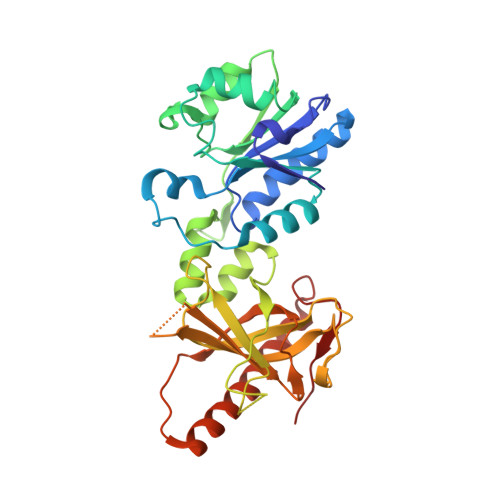The trimer interface in the quaternary structure of the bifunctional prokaryotic FAD synthetase from Corynebacterium ammoniagenes.
Serrano, A., Sebastian, M., Arilla-Luna, S., Baquedano, S., Herguedas, B., Velazquez-Campoy, A., Martinez-Julvez, M., Medina, M.(2017) Sci Rep 7: 404-404
- PubMed: 28341845
- DOI: https://doi.org/10.1038/s41598-017-00402-6
- Primary Citation of Related Structures:
5FNZ, 5FO0, 5FO1 - PubMed Abstract:
Bifunctional FAD synthetases (FADSs) fold in two independent modules; The C-terminal riboflavin kinase (RFK) catalyzes the RFK activity, while the N-terminal FMN-adenylyltransferase (FMNAT) exhibits the FMNAT activity. The search for macromolecular interfaces in the Corynebacterium ammoniagenes FADS (CaFADS) crystal structure predicts a dimer of trimers organization. Within each trimer, a head-to-tail arrangement causes the RFK and FMNAT catalytic sites of the two neighboring protomers to approach, in agreement with active site residues of one module influencing the activity at the other. We analyze the relevance of the CaFADS head-to-tail macromolecular interfaces to stabilization of assemblies, catalysis and ligand binding. With this aim, we evaluate the effect of point mutations in loop L1c-FlapI, loop L6c, and helix α1c of the RFK module (positions K202, E203, F206, D298, V300, E301 and L304), regions at the macromolecular interface between two protomers within the trimer. Although none of the studied residues is critical in the formation and dissociation of assemblies, residues at L1c-FlapI and helix α1c particularly modulate quaternary architecture, as well as ligand binding and kinetic parameters involved with RFK and FMNAT activities. These data support the influence of transient oligomeric structures on substrate accommodation and catalysis at both CaFADS active sites.
Organizational Affiliation:
Departamento de Bioquímica y Biología Molecular y Celular, Facultad de Ciencias, and Institute of Biocomputation and Physics of Complex Systems (Joint Units BIFI-IQFR and CBsC-CSIC), Universidad de Zaragoza, Zaragoza, Spain.
















